Oxalic Acid: Part 1- Questions, Answers, and More Questions
Oxalic Acid: Part 1 (of 2)
Questions, Answers, and More Questions
Why Oxalic Acid?
©Randy Oliver 2006
ScientificBeekeeping.com
First Published in ABJ in December 2006
European beekeepers, who have dealt with varroa much longer than we have, and who often face regulations that do not look favorably upon chemicals that may contaminate honey, noted that varroa is susceptible to organic acids–such as formic (in ants), acetic (vinegar), lactic (milk acid), citric (citrus fruits), and oxalic (in many plants, including Oxalis). They have done considerable groundbreaking research as to the effectiveness of each of these.
Both lactic acid and acetic acid have shown some effectiveness in killing varroa, but oxalic has become the organic (carbon-containing) acid of choice. It is approved for, and much used in, a number of European countries, Canada, and New Zealand. It is not yet registered for use in the United States, and as such, this article is directed toward our foreign friends, and informational only for U.S. beekeepers. The ABF, headed by Troy Fore, has petitioned the Feds for registration of OA in sugar syrup, based upon research by Marion Ellis, of the University of Nebraska.
Oxalic is unusual for an organic acid, which are normally “weak” acids, in that it has a very high dissociation constant—meaning that it acts more like a “mineral acid,” like sulfuric or hydrochloric, than your typical carboxylic acid, like acetic or citric. You could sprinkle pure crystals of citric acid on your tongue (they coat sour gummy worms), and it’s no big deal. If you were to do the same with oxalic acid, you could “burn” the skin right off! Oxalic is about 10,000 times “stronger” than the acetic acid in vinegar (vinegar is a 5% solution of acetic acid).
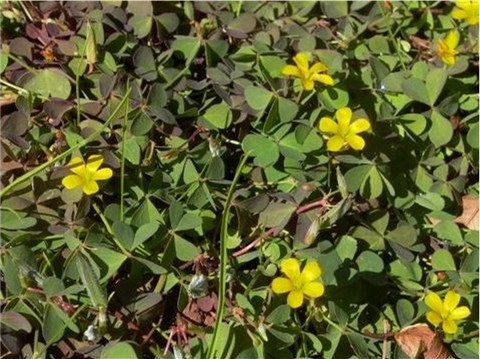
Photo of common Oxalis sp. Most kids recognize the sour taste of the flower stems, which is due to oxalic acid.
Oxalic acid is common in the plant kingdom, because it is repellent to herbivores. It does a few things:
1. It makes the plant taste sour—go ahead and taste buttercup oxalis, rhubarb, or spinach. The grittiness you feel on your tongue is the oxalic acid reacting with the calcium in your saliva to form oxalates (salts of oxalic acid).
2. It can make the sap irritating to the mouth, skin, or eyes.
3. It ties up calcium in the animal’s gut, and cause kidney stones if eaten for extended periods.
4. It can form oxalates. The leaves of one common houseplant Dieffenbachia are noted for this; in fact, the common name of the plant is “dumbcane,” because if you eat it, your tongue will swell up, rendering you unable to speak, or “dumb.” Do not try this experiment: “The [oxalates in] the leaves… are needle-like crystals, which, when eaten, may pierce the mouth, throat and digestive tract as they pass through, causing, at the very least, intense discomfort.” (http://en.wikipedia.org/wiki/Calcium_oxalate).
There are many common vegetables that contain oxalic acid or oxalates (http://www.nal.usda.gov/fnic/foodcomp/Data/Other/oxalic.html). The natural concentration of oxalic acid (oxalates) based on fresh weight in spinach is 0.3-1.2%, in rhubarb 0.2-1.3%, in tea 0.3-2.0%, and in cocoa 0.5-0.9% (Fassett 1973). For the following reasons, oxalic looked like a sure winner for mite control:
1. It’s a natural part of our diet, so we have a metabolism to deal with it.
2. It’s a natural part of the environment, so we’re not going to be poisoning anything but the mites.
3. Since it is not lipid (fat) soluble, it will not build up in the wax of the combs.
4. It is a natural component of honey, and treatment with oxalic does not appreciably increase the concentration of it in honey (Brødsgaard, 1998).
5. It is safe and easy to apply (I’ll cover safety and risks at the end of the article).
How Does One Apply It?
Don’t forget: oxalic acid is not yet approved for use in the United States of America.
Application by “dribble”
The Europeans have done tons of work on this, and have arrived at the conclusion that “dribbling,” rather than spraying is safest and effective. It can be dribbled by syringe, turkey baster, or (probably the easiest) a garden sprayer with the tip backed off to give a gentle squirt stream that doesn’t splash. Many prefer the garden sprayer, since it keeps your eyes far away from any splash and you don’t have to bend over to squirt it onto the bees.
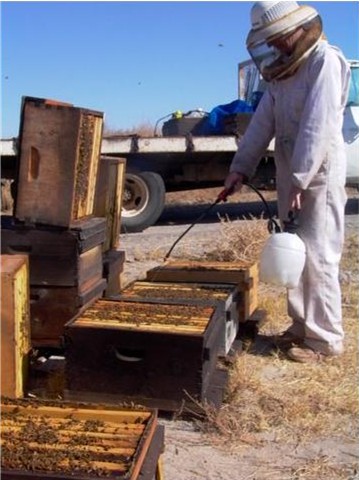
My partner Stephanie Hughes applying oxalic dribble in Nevada. Two people can treat 250 colonies before lunch!
To apply with a garden sprayer (the Gilmour funnel-top “BackSaver” 1-gal model in the illustration is especially handy), pump up a medium-low pressure, then back off the nozzle adjustment until you get a solid, weak stream that shoots out several inches, and doesn’t splash when it hits the bees. Use a graduated cylinder or measuring cup to calibrate how many ml (milliliters) your sprayer puts out per second. Then figure how many total seconds of “trigger on” you need to apply the dose. Adjust the pressure and nozzle so that the right dose per frame is applied in 1 second—then you can just squirt for 1 second down each “seam” of bees between the frames to apply the correct dosage. With experience, you can accurately judge your dosing rate by the appearance of the stream. Tip: if you’re treating a number of colonies, check the total amount you’ve used upon completing a yard, and divide by the number of colonies treated—this will tell you how accurately you’re applying it.
When dribbling, the best results are obtained by squirting the dose directly on each seam, with the wand in line with the frames. It’s easiest to aim to if the dribble squirts out at a low angle about 3-4 inches before it hits the bees (you can drag the tip between the frames, but you get more splashing that way). Syrup that lands on the frame tops does not count–the bees are slow to remove it. Don’t worry if your (shaky) aim is off at first, it will improve with a little practice. Research indicates that it’s not critical to apply the syrup evenly–the bees will move it around (but it’s better to apply it to evenly). Total dose per colony is the most important thing.
Some beekeepers work in pairs, first working ahead to break the propolis holding the brood boxes apart, and then returning for one person to tip the upper brood chambers well back and the other working the sprayer. Squirt the upper box from the bottom, the lower box from the top. Just run the stream up and down the seams of bees, counting off seconds (no need to even let the trigger off). It’s easy to treat a colony per minute, and not hard to move nearly twice that fast! Two beekeepers can treat 250 colonies before lunch! Tip: you’re stuck if your sprayer malfunctions–take more than one to outyards.
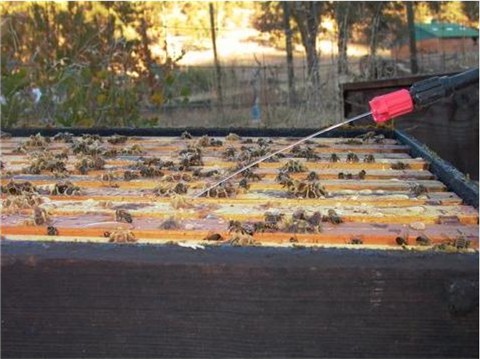
Use a gentle squirt between the frames. Your hand may shake until you get used to it. Normally there would not be much syrup on the top bars—I had trouble “getting the shot.”
When Should I Treat?
Oxalic acid treatments fall into two categories:
Winter broodless application Oxalic acid is well researched for a Fall/Winter broodless application, or can be used in colonies made broodless by manipulation—such as (1) to treat package bees, or (2) to make “clean” nucs. Accurately measure 3-5ml of 3.5% w:w solution per seam of bees, and treat one time only, or you can harm your colonies. E.g., for a colony with 10 frames covered with bees, dribble a total of 30-50 ml of solution. Mite kill is 90% or greater!
Spring/summer application(s)* This is much less effective, since oxalic does not kill mites in the brood. There is some controversy as to summertime application (see Does it Harm the Bees?). You’re on your own here, but the bees seem to handle one shot well (even at high doses); multiple applications are more questionable. Those using it generally apply about 5ml per seam of 3.5% w:w solution.
*Note that no chemical or drug should be applied to honeybee colonies during the summer season when honey supers are on, unless the supers have been removed for the season.
The overwhelming evidence is that oxalic is most effective and easiest on the bees during the winter broodless period. However, it is handy for making “clean” nucleus colonies–if you hit a mating nuc with oxalic just as the last of the old brood is emerging, you can start with a nearly mite-free colony. This treatment apparently does not affect new queen survival.
How Effective Is It?
Fall/Winter dribble (broodless)
After dribbling, you’ll see a (very gratifying) big mite fall the first day, then tapering off for about a week. Gregorc and Planinc (2001) found that solutions as weak as 2.9% w:w OA in 32% sucrose were highly effective in broodless colonies. Charriere and Imdorf (2002) found that a winter treatment with solutions of 2.4-3% w:v OA in 50% syrup at the rate of 5-6 ml/seam of bees resulted in mite kills of 95-99.7%, with the higher values from the 3% solution. Nanetti, et al. (2003) thoroughly review winter treatment studies in Europe. They recommend 4.2% w:v (which is 3.5% w:w) in 60% sugar syrup—all trials had at least 90% efficiency. They concluded that 30% sugar syrup was somewhat less effective, and was no easier on the bees.
At the University of Nebraska, Ellis and Aliano (2005) found that a single treatment of 5-6 ml of 3.5% syrup dribbled per seam of bees resulted in about a 90% mite kill. They also found that a 2% oxalic solution was far more effective than Sucrocide® (62% compared to 32%) at killing mites on package bees.
Beekeepers experience with winter dribble in northern California reflects the excellent European results—it’s difficult to find a mite in a colony in late February.
Spring/Summer dribble (brood present)
The most impressive thing beekeepers notice the first time they use oxalic (as a summer treatment on badly-infested colonies with “curlywing” virus) is the remarkable change in the appearance of the bees. A week following treatment, the dull, listless, “demoralized” looked noticeably bright and peppy, and curlywing was nowhere to be seen. I know that “peppy” is not a scientific term, but you’ll see what I mean.
Gregorc and Planinc (2001) found that in summer 3.4% in 48% sucrose worked best. There was no observed harm to bees or buildup. Three treatments in August 9 days apart gave 44% mite kill.
Ellis and Aliano found that three weekly summer dribbles of 40 ml of 3.5% w:w per single box of bees resulted in a 60% reduction in mites (although the control experienced a 41% reduction without treatment); for the similar treatment with Sucrocide, the mite population increased by 35%! Ellis feels that the brood acts as a “robust buffer” of mites that prevents treatment under those conditions from being very effective.
Asking around, the jury’s still out, in my opinion as to whether OA summer treatment is worthwhile, due to relatively low efficacy, and demonstrated damage to the brood (see below). The later in the season, and the smaller the brood nest, the more effective the treatment is. In the short term, though, it sure causes a major drop of mites!
Does It Harm The Bees?
Ellis and Aliano found that OA is about 70 times as toxic to mites as it is to adult bees—which is a much greater spread than with either thymol or formic acid. The bees normally do not react defensively to being dribbled with syrup, but on rare occasions run out the entrance for a while. Occasionally one will notice a little adult bee kill after oxalic treatment. Adult bee kill does not seem to be an issue. However, there are questions about subtle effects, larval kill, and lasting suppression of brood development.
As far as winter broodless dribbling, it is absolutely critical to treat them only once, with exactly the right amount and concentration of OA. More than one winter treatment clearly hurts the bees. Charriere and Imdorf (2002) found that colonies treated with 5-6 ml/seam of 3% OA were only 85% the strength of controls by April 25. The best review is in Anonymous (1999). Typically, winter bees treated with OA start out a little slower, but catch up by the end of March.
Spring/summer treatments
With summer dribbling, it is easy to overlook any effect of OA on brood rearing, especially if applied to late summer colonies that are not on a honeyflow, and were stressed by mites. Local anecdotal reports didn’t notice any frank effect, but they weren’t really measuring. One study of late gives us pause. Hatjina and Haristos (2005) is the only study I’ve found that reports significant problems to brood development following OA dribble. The authors recommend against summer treatment. The study was performed in Greece, “during the summer, between honey flows.” A question that is begging to be answered is: whether OA efficacy or brood mortality is affected by the amount of nectar flow during treatment.
Brødsgaard, et al. (1998) Treated colonies once in late March, and measured brood areas. “Neither the residues of oxalic acid in honey, the GST activity, nor the colony development after spring treatment with either trickling or spraying with oxalic acid seem to indicate any problems.”
Heinz Kaemmerer of Heilyser Technology says:
“You can treat your colonies with a liquid mixture of OA and sugar but be careful. The liquid acid shortens the life of the bees. There is no problem during summer because the bee’s life not longer than approximately 6 weeks. The problem starts with winter bees–do not treat your winter bees more than one time with liquid OA. When using liquid OA bees get wet and have to clean each other. The result is, the acid ends up in their stomach and during winter without a cleaning flight it shortens the life of the bees. Two treatments on winter bees might kill the colony. Liquid OA is a slow killer and bees will probably die after a few weeks or month instead reaching the next season.”
Do not be in the “If a little’s good, a lot would be better” mentality with oxalic. It can be rough if over applied to the winter cluster, and is rough on the brood in the summer colony. However, be aware that most other treatments also affect the brood (amitraz, formic, thymol), queens (coumaphos), or drones (fluvalinate).
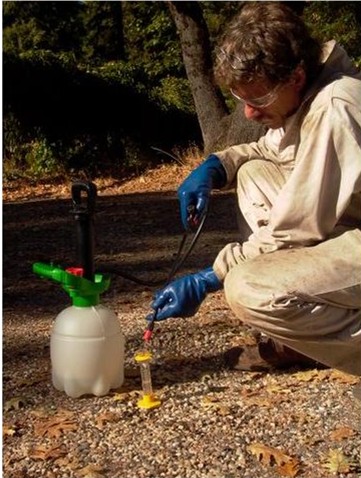
Be absolutely sure to calibrate your sprayer output to about 5ml per second. Unless you do, I guarantee that you will over apply it! Recheck from time to time.
Where Can I Purchase OA?
Oxalic acid dihydrate (not dehydrate; oxalic acid dihyrate is 71.4% pure oxalic acid) can be purchased in any paint department as “wood bleach.” It usually comes in a 12 oz plastic tub. Check the ingredients label, or call the manufacturer to make sure there are no added ingredients. It can also be purchased much more cheaply in bulk (less than $1/lb) from chemical supply houses.
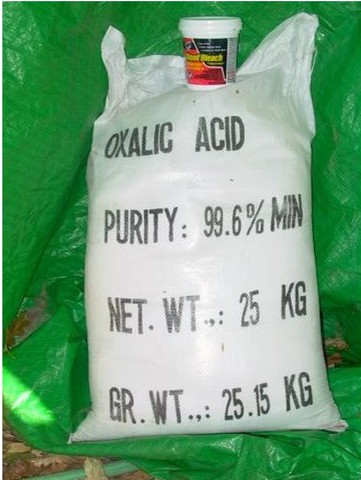
Oxalic acid can be purchased as “Wood Bleach” in most hardware stores, or from a chemical supply house much more cheaply per pound. The $50 sack contains enough to treat 25,000 10-frame colonies!
Unanswered Questions About Oxalic
Mode of Action
Many plants use oxalic acid, and/or its oxalate salts, to discourage insects and large animals from eating them. This leads us to the hope that OA might be a long-term “organic” weapon for mite control. Funny thing is, no one really knows how OA kills mites, although there is a great deal of conjecture in the literature! One might assume that its mode of action would be similar to that of formic acid, which forms a vapor at hive temperatures. According to Imdorf (Anonymous 1999), formic kills by “respiratory inhibition,” although he doesn’t cite a source for this statement.
A number of authors hypothesize that OA also sublimates in the hive. However, if they would read a chemistry text, they’d see that oxalic acid does not sublimate to any extent (as evidenced by the porous sacks in which it is sold wholesale, and the lack of odor) at normal temperatures. The vapor pressure (measure of a substance’s propensity to evaporate) of oxalic acid is less than 0.001 mm Hg @ 20C (68F). For comparison, the vapor pressure of paradichlorobenzene (mothballs), which readily sublimates, is 0.6 mmHg—more than 600 times as strong. I think we can rule out sublimation as a mode of action (or as a health hazard).
So, is it the acid or the oxalates that affect the mite? In European research (Nanetti, in Anonymous 1999) the efficiency of oxalic acid was compared to neutral potassium oxalate. They determined that it is the acidity, rather than the oxalate ion, that kills varroa.
We still didn’t know whether the acidity of OA killed the mite through ingestion of acidic bee “blood,” or by direct contact. Ellis and Aliano (2005) performed a clever experiment: By splitting single dequeened colonies with various dividers, and treating only one side, they found that oxalic is apparently transferred through the colony by bee body contact, rather than through trophallaxis (mouth-to-mouth transfer), and distributes well by such contact (80% kill on treated side, 65% kill on untreated).
OK, so OA spreads and kills by contact—that’s why heat vaporization (to be covered in the next installment) works well. We still don’t know how it gets into the mite’s body (no one’s proposing that mites crawl around licking the stuff up). We do know that oxalates in plants form spiky crystals that can penetrate animal tissue, similar to those of boric acid (commonly used for cockroach and ant control). Boric acid forms abrasive spikes that can penetrate the soft integument at the joints of the insect exoskeleton, and apparently desiccate the insect. It also acts as a stomach poison to ants.
Could oxalic acid work in the same manner? Heat vaporized OA does form tiny spiky crystals, as does OA evaporated from a water solution. But oxalic dissolved in sugar syrup dries to a clear, smooth, candy that shows no crystal structure (personal microscopic observations). The rub is, OA is only effective when dribbled in a sugar solution (Anon 1999), not in plain water. So go figure! We’ll leave the mode of action discussion at that…
Fall/Winter treatment questions
Why is the interplay between sugar concentration and acid concentration, in that small differences make big differences in mite mortality and bee tolerance? Would OA be safer if mixed with something other than sugar?
Spring/summer treatment questions
Are they worthwhile? Is the tradeoff in mite kill worth the subsequent suppressed brood production?
Does it make a difference if there is a honey flow on, or if the bees are being fed syrup concurrently?
Mitigation questions
It appears that the main problem with OA is that it is tough on the bees if they ingest it. Also, it follows that if the anecdotal reports that heat-vaporized OA doesn’t hurt the brood, it is likely that brood damage is also due to problems from nurse bees ingesting the acid. If these are the cases, then perhaps beekeepers could mitigate the harm by feeding a buffered sugar syrup (or candy patty) concurrent with dribble treatment. I did a little experimentation in the lab, and found that OA in solution precipitates out as (apparently) oxalates if mixed with calcium chloride or calcium hydroxide. It is neutralized by calcium hydroxide or baking soda. These chemicals are inexpensive and readily available, and are crying for someone to test this hypothesis.
How often to use it?
Will overuse of oxalic acid result in its becoming just another “Silver Bullet” with a limited effective life, due to mites evolving resistance? I strongly suggest using it to knock back mite levels only once a year. Otherwise, we’ll just be breeding for OA-resistant mites—especially if you’re also using formic acid!
Conclusions
Oxalic acid appears to be an inexpensive, easy to apply, safe, highly effective, environmentally benign miticide to include in our arsenal of mite control weapons in an overall IPM strategy. It does have its limitations and problems, and the potential for personal injury if handled carelessly. The Europeans, Canadians, and New Zealanders (and myself) have embraced it wholeheartedly as a Fall/Winter, one-time treatment of the broodless cluster applied by the dribble method:
THIS IS ALL YOU NEED TO REMEMBER: Apply one time only: 3-5 ml of 2.8% w:w oxalic acid in 50% sugar syrup per seam of bees as soon as the colony goes broodless. Please see “The Learning Curve, Part 3” for updates!
It (or lactic acid) is a common feature of most IPM strategies. The important thing to remember is: if we use it judiciously, it will likely be effective for a long time to come. Misuse, by over treatment in concentration, or in number of applications per year, can be deleterious to the bees and brood, and would likely lead to the mites developing resistance to its mode of action.
Remember: oxalic acid is not yet registered as an approved miticide in the United States. If you live in a country where it is approved, follow the appropriate methods of application. The tips below may be of some help:
Mixing Tips
See the safety tips below. Mix in a sink where you can rinse everything off. Oxalic crystals clump up and do not measure at all well by volume, so you must have a scale accurate to 1 gram to measure it.
For amounts less than a gallon, weigh the crystals, and then pour them into a quart or gallon jar with a plastic lid (do not use metal). Add half the warm water, and shake ’til the OA is completely dissolved, then add sugar, and the rest of the water. Shake until all the sugar is dissolved before putting the solution into a sprayer–undissolved crystals will clog the sprayer! It’s tempting to just mix everything in the sprayer, but you’d be inviting problems.
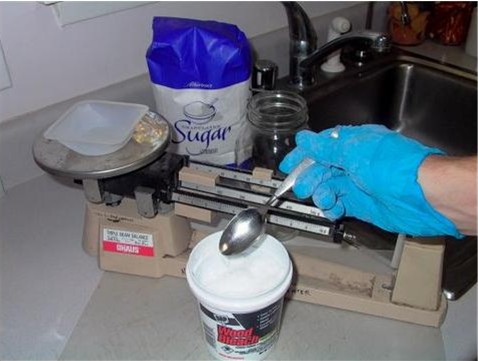
Oxalic crystals are easy to handle. Wear gloves to remind you not to rub your eyes! The crystals must be weighed accurately—they do not measure well by the teaspoon!
The solution forms bee-toxic HMF in warm weather, so use within a week, or refrigerate for prolonged storage (Bogdanov 2001). Discard the solution if it starts to take on a tan tint. It’s cheap, so make plenty, then dispose of any excess down the drain, or neutralize with baking soda.
Formulas
If you want to get good and confused, just try to keep straight the concentrations used in the literature. Most Europeans use w:v (weight of acid to volume of syrup) formulas (easy to use: e.g., 35 g oxalic in a liter of syrup is 3.5% w:v); some Europeans, and most Americans, use w:w (weight oxalic: weight sugar + weight water + weight oxalic again). If you’re not careful, it’s easy to screw up. Plus there are many errors in publications (I just let a Canadian province know that they had an error on their official website!). Confusingly, both 3.5% w:w and w:v solutions are used—so I’d just stick to one method of mixing!
For specific updated mixing formulas, please go to “The Learning Curve—Part 3.”
Update October 2011–search on this site “Oxalic Acid Treatment Table” or go to https://scientificbeekeeping.com/oxalic-acid-treatment-table/
How Safe (or Dangerous) Is It?
From the varroa mite’s point of view, it’s pretty dangerous stuff. But I imagine that what you’re really asking is “How dangerous would it be to my own person if I were to use it for mite control? The label looks pretty scary!”:
POISON! DANGER! MAY BE FATAL IF SWALLOWED. CORROSIVE. CAUSES SEVERE IRRITATION AND BURNS TO SKIN, EYES, AND RESPIRATORY TRACT. HARMFUL IF INHALED OR ABSORBED THROUGH SKIN.
Health Rating: 4 – Extreme (Poison)
Flammability Rating: 1 – Slight
Reactivity Rating: 1 – Slight
Contact Rating: 3 – Severe (Corrosive)
Toxicological Information
Oral rat LD50: 375 mg/kg; irritation skin rabbit: 500 mg/24H mild; eye rabbit 250 ug/24H severe
Plus, all the governmental regulations tell you to wear protective clothing, safety glasses, gloves, and sometimes respirators. You may be saying, “OK, just what does all that chemical gobbledygook really mean? I know that everyone covers their butt by giving you so many safety warnings that you’re afraid to touch anything! Please, can you just give us a reality check on how careful we have to be?”
Common Sense Safety Advice
Of course, I should just cover my butt, too, and parrot dire warnings. Look, I don’t want to sound cavalier, but my impression is, that those issuing such extreme cautions haven’t actually read the toxicological studies themselves. Folks, I feel the same as you, and some chemicals, like the coumaphos in Checkmite+®, scare the heck out of me. That chemical is an organophosphate, and one dose can cause permanent nerve damage! Oxalic acid is not like that—it’s not an insidious chemical. OA is right up front—if you try to inhale it, you’ll cough and stop; if it gets on your skin, it’ll burn a little, and you’ll wash it off. About the only way you have any realistic chance of injury is if you get the crystals in your eyes (it would take swallowing a full ounce to kill you). As far as the short-term exposure you’ll have to it, think of it as an “irritant,” rather than as a “poison.” In practice, it’s not difficult to handle the product safely. If you have the skill to safely handle lye, swimming pool acid, or bleach, you’ll be fine with oxalic!
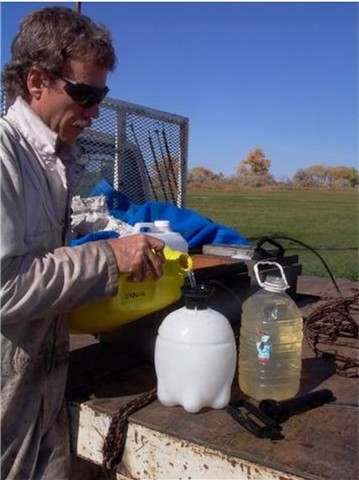
Wear safety glasses when pouring. Keep rinse water at hand!
Handling the Crystals
When you’re handling the crystals, wear safety glasses and gloves: thin (so you’re not clumsy) nitrile or latex gloves are fine (Kimberly-Clark 2006). The crystals that you will be buying are oxalic acid dihydrate (dihydrate, as opposed to dehydrate–which means that there are two molecules of water bound to each molecule of acid). Because of this, common oxalic acid crystals have a “damp” feel, and don’t go flying all over the room. You’re not going to inhale them or get them in your eyes unless you fling them up there by using a springy cheap plastic spoon. Unless–you purchase it in the little plastic 12 oz containers at the hardware store, as they have a diabolically-designed lid that wants to fling crystals everywhere when you try to pry the dang thing off! I suggest that you do all your opening of containers and mixing in, or next to, a sink (see Common Sense Safety below).
Dribbling the Syrup
The reason the Europeans decided upon the dribble method, rather than spraying, is so that you don’t have any chance of inhaling droplets in the air (oxalic acid, unlike formic, does not make fumes). That only leaves two ways for it to get into your system: by drinking it (it would take about 3 cups of the 3.5% solution to kill you), or by absorbing it through your skin (the amount of OA that you squirt on one colony is about the same as Popeye would have gotten in a serving of spinach). If you spill OA syrup on your skin you may feel a slight burning sensation until you rinse it off. You likely eat more OA in vegetables and tea than you’ll ever absorb through your skin from dribbling. Indeed, your own body produces OA as a normal breakdown product of excess vitamin C!
The best reality check I found was published by the Health Council of the Netherlands (2004)—read it yourself! To summarize their findings, oxalic crystals can burn your skin or eyes, and shouldn’t be inhaled. But you’d have to drink a lot of the syrup for a long time before it hurt you by depleting calcium in your system or forming kidney stones. When researchers bathed rabbit skin with OA, they saw some redness, but even bathing rabbits in 5% solution didn’t kill ‘em. C’mon, to put the strength of the syrup into perspective, the 3.5% w:w solution (the strongest used) is only about twice the oxalic acid concentration naturally occurring in chives, parsley, and rhubarb! Radetzki states that a housewife cutting rhubarb is exposed to higher levels of OA than a beekeeper handling treated bee equipment. Some hair-care products contain up to 5% OA! When used as wood bleach, the recommended solution of OA to splash and scrub all over your deck is 2½ times as strong as used for mite treatment!
The Health Council concludes: “In rabbits, oxalic acid was mildly…irritating to the skin…. The committee considers irritation of the upper respiratory tract, eyes, and skin to be the critical effects in occupational exposure to oxalic acid.” In other words, don’t get it into your eyes, and wash it off your skin. Always do wear glasses around it; don’t wear your leather bee gloves because it will soak in and may eventually sensitize your skin. You’ll notice if it gets on your skin, because the syrup is sticky. Always do keep plenty of water at hand for washing off your hands or spills on your clothes, and rinse off your hands every time you put down the sprayer, so you don’t inadvertently rub it into your eyes, or get it on the steering wheel of the truck.
Practical Safety Tips
1. Number one rule: Always have plenty of rinse water at hand!
2. Wash your hands before you rub your eyes or pick your nose!
3. Mix and store oxalic acid solutions in glass or plastic containers, not metal (most common plastics are resistant to dilute acids). Clearly label any container of solution. Minimally state: “Poison: 3.5% oxalic acid.” Rinse all mixing vessels and containers as soon as you are finished—don’t leave them lying around!
4. Once the solution is mixed, it’s much safer to handle. But be especially careful not to splash it into your eyes, or breathe any sprayer mist. Dribble it at arm’s length, and keep your face away. If it gets on your skin, wash it off with water. Tip: if you question whether any acid is still on your skin after rinsing, some applicators touch the tip of their tongue to the skin. If it tastes tart (like lemonade), there’s still acid remaining (authorities caution against this test; in reality, if you were to taste rinsed skin, you wouldn’t ingest more OA than you’d get in a sprinkle of black pepper).
5. Make sure you always have jugs of water handy to wash off spills–especially in outyards. Baking soda dissolved in water will neutralize any acid. Don’t use oxalic unless you have plenty of wash water at hand!
6. Make sure you use low pressure with the sprayer, so the solution doesn’t splash or mist. When using a garden sprayer, make sure you release the tank pressure between yards (or applications), so no one gets sprayed in the eyes by bumping the trigger accidentally!
UPDATES
Here are a few things I’ve learned since I wrote my article on OA in ABJ:
1. The paper by Nozal (Apidolgie 34: 181-188) cited earlier clearly
demonstrated that OA is absorbed through the bees’ cuticle, and makes its
way to various organs. That study, when I read it some time ago, helped
answer a few vexing questions, but not all. The data indicate that 6
microliters of 10% OA in water applied to a bee resulted in a brief spike in
OA in the hemolymph at 2 hrs, after which it returned to normal. There was
nearly no change in the amount of OA in the rectum, Malpighian tubules, or
digestive tract.
2.Revised 1/11/2019 To my knowledge, the mode of action of OA on the mite is still not
known, although studies by Ellis and Aliano demonstrate that it is quite
toxic to the mite when topically applied. However, there are reports that
OA syrup fed to bees (when they could be induced to eat it) also killed
mites. The fact that OA gets into bee hemolymph suggests that one mode of
action may be from mites ingesting low pH hemolymph (since oxalic salts
don’t kill mites). However, in practice, OA dribble kills mites for about only a few days. Nozal’s paper suggests that the OA in bee hemolymph spikes at 2
hours. More recent studies indicate the the main effect of oxalic upon mites is direct absorption into the mites’ bodies via either the empodia (the sticky inflatable pads on their feet– likely the main route), or directly through their exoskeleton. Absorption through the exoskeleton appears to be dependent upon their being a humectant associated with the acid to allow it to better penetrate a mite’s cuticle — sugar or glycerin appear to serve this purpose. But recent work by Toomema indicate that by simply increasing the amount of dribble applied to the bees, one can decrease the concentration of acid, forego the humectant, and still get a good mite kill (Kalle Toomemaa (2019) The synergistic effect of weak oxalic acid and thymol aqueous solutions on Varroa mites and honey bees, Journal of Apicultural Research, 58:1, 37-52).
3. The effect of the sugar in the OA solution is apparently as a humectant,
which allows the acid to be absorbed more effectively through the bees
chitinous “skin.” Glycerin will do the same. Plain water when it’s humid
enough.
4. Several European studies found that spring buildup was slightly reduced
temporarily in colonies that received winter treatment with oxalic,
indicating that there was some sort of sublethal effect on the bees. Our own experience, after we dribble 3000 nucleus hives each spring, is that a dribble at that time does not appear to adversely affect the nucs
https://scientificbeekeeping.com/simple-early-treatment-of-nucs-against-varroa/
https://scientificbeekeeping.com/does-oxalic-acid-treatment-of-nucs-affect-honey-production/
5. Anecdotal reports to me demonstrate that overapplication (too much per
treatment) of OA can be frankly harmful to colonies. DO NOT EXCEED THE
RECOMMENDED DOSAGES. Gregorc (Apidologie 35:453-460) found that OA caused
increase cell death in bee larva gut epithelial cells.
6. Dr. Ellis’s experience, anecdotal reports, and my own experience
indicate that colonies can handle the recommended dosages well, even with
multiple summer treatments. Anecdotal reports that they don’t handle
multiple winter treatments well. I have not seen any studies as to the
effect of nectar or pollen availability on sublethal effects of OA. More
studies need to be performed re prolonged wintering of OA-treated bees.
7. There are concerns about overuse of oxalic. First, that residues may
build up in colonies (although I have seen data to the contrary). Where OA
is used extensively and repeatedly in some European countries, some suspect
it of causing harm to colonies. I suggest that you only use it once a year.
8. The organic acids are rough chemicals! They clearly have side effects.
However, the CCD team has not linked OA use to colony collapse, nor have I
in my own operation. Oxalic is not a miracle drug–it is simply a
relatively safe “natural” chemical alternative to synthetics. I recommend
that it be used only if needed, in a comprehensive IPM program. Use itGood source of references on OA: HATJINA, HARISTOS 2005 Indirect effects of oxalic acid administered by trickling method on honey bee brood J. Apic Res. 44:4, p. 172 to 174
Citations
Brødsgaard, Jensen & Hansen. 1998? Spring treatment with oxalic acid in honeybee colonies as varroa control. Danish Inst of Agri. Sci.. www.beekeeping.com/articles/us/spring_treatment_oxalic_acid.htm
carefully (where legal), and do not overuse it.
Please go to The Learning Curve 3 for updates.
More Information
This is one of the best European websites:
http://www.agroscope.admin.ch/imkerei/00316/00329/02081/index.html?lang=en
It contains:
1. J.D. Charrière, A. Imdorf, R. Kuhn (2004) Bee tolerance of different winter varroa treatments.
2. Bogdanov, Kilchenmann, Charrière, Imdorf (2001) Storage of Oxalic Acid Sucrose Solution
3. Gumpp, et al. 2003 Evaporation of oxalic acid—a safe method for the user?
Lots of European OA info: Anonymous 1999. FAIR CT97-3688. “Coordination in Europe of integrated control of Varroa mites in honey bee colonies.” 1999 Final Technical Report Appendix VI (Broken Link!) www.alp.admin.ch/themen/00502/00567/00573/index.html?lang=de
Ellis, M. & Aliano, N. 2005. Prepublication presentation at the 2005 California State Beekeepers Convention.
Fassett, D. W. 1973 Toxicants occurring naturally in foods, chap. 16: Oxalates, p.346-362. National Academy of Sciences, Washington, D.C., USA
Gregorc and Planinc. 2001. Acaricidal effect of oxalic acid in honeybee (Apis mellifera) colonies. Apidologie 32: 333-340.
Gregorc A., I. Planinc 2004 Dynamics of Falling Varroa Mites in Honeybee (Apis mellifera) Colonies Following Oxalic Acid Treatments. Acta Vet. Brno (73): 385-391.
Health Council of the Netherlands 2004 Oxalic Acid: Health-based Reassessment of Administrative Occupational Exposure Limits http://www.gr.nl/pdf.php?ID=935
Radetzki Vaporization of oxalic acid and working safety www.mellifera.de/Engli2.pdf
Kimberly-Clark 2006
(Broken Link!) http://www.safeskin.com/ChemResist/search.asp?o=1



